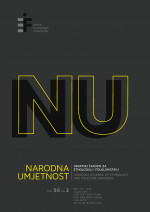Čovjek, ali najbolji: Romi u žrvnju radne, jezične i biološke teorije rase
Man, but the Best One: Roma Caught in Labour, Language, and Biology-Based Theories of Race
Author(s): Borislav MikulićSubject(s): Anthropology, Language and Literature Studies, Philosophy of Religion, Philosophy of Language, Labor relations, Migration Studies, Ethnic Minorities Studies
Published by: Institut za etnologiju i folkloristiku
Keywords: Roma-Studies (Gypsy Studies); migrant worker; nomadic subject; Kant; labour ethics; orientalism; sexualization of otherness; aryanness; the Ahnenerbe project;
Summary/Abstract: Starting with the paradox that the Roma, as traditional Central European itinerant people, seldom appear in recent European debates on the “Migration Crisis”, this paper addresses the notion of labour associated with the negative figure of the “lazy nomad”, which, from the beginnings of academic reflection about the Roma in the 18th century, determines both their public image and their ethnic, racial, and linguistic origin. Within this framework, special attention is paid to the fact that the Roma generally appear in art and culture as carriers of the “orientalist” syndrome of ‘gypsiness’ consisting of idealized and sexualized otherness and libertinage although the fictional narratives they appear in often provide evidences of a different self-understanding of the Roma opposing the stereotypes and prejudices concerning labour. Contrary to the literature, the rather sporadic presence of the Roma in the theoretical discourse of philosophy is characterized by a tacit recycling of their history for the conceptual apparatus of contemporary philosophy. Their anonymous presence can be illustrated by the postmodern inversion of Kant’s negative simile of sceptics in philosophy as nomads for the positive concept of ‘nomadic thought’. This figure can be traced back to its origin in Kant’s texts and submitted to a more detailed analysis of Kant’s relationship to the first known “Gypsy-Project” by his friend Christian Kraus. In the second part, the paper tackles the “rediscovery” of the Roma by the mid- 20th century Indian cultural and national politics based on the ideological assumptions of the late 19th century neo-Hinduist movement Arya Samaj, aiming at “Making the Universe Aryan”; it is confronted with the pre-war national-socialist movement, established and directed by H. Himmler, for the “Aryanization” (Arisierung) of the “entire cultural world” under the name Ancestors’ Heritage (Ahnenerbe). In the final part, the total symbolic deprivation of the Roma-People by the National Socialist misappropriation of “Aryanness” is interpreted as the most radical form of dehumanisation, which—in contrast to the annihilation of European Jews and Slavs—was carried out without any justification. On this basis, it is contrasted with the paradigmatic human self-understanding by the Roma themselves implied in their very name.
Journal: Narodna umjetnost - Hrvatski časopis za etnologiju i folkloristiku
- Issue Year: 56/2019
- Issue No: 2
- Page Range: 7-39
- Page Count: 33
- Language: Croatian

